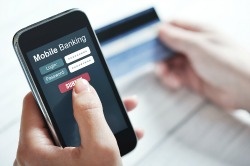Are Biometrics the Future of Credit Union Security?
 With the increased use of mobile banking apps, cybersecurity has quickly come to the forefront as an imperative measure to guard against hacking and fraud. In a recent study, researchers predicted that smartphone subscriptions could hit six billion globally by 2020, and 81% of adults in the U.S. will be using mobile banking. As all of these members transmit their usernames, passwords and account information over the local area WiFi, there is an increasing amount of vulnerability that could lead to their information being compromised.
With the increased use of mobile banking apps, cybersecurity has quickly come to the forefront as an imperative measure to guard against hacking and fraud. In a recent study, researchers predicted that smartphone subscriptions could hit six billion globally by 2020, and 81% of adults in the U.S. will be using mobile banking. As all of these members transmit their usernames, passwords and account information over the local area WiFi, there is an increasing amount of vulnerability that could lead to their information being compromised.Similarly, online banking has also felt the impact and the need for more robust security measures, as credit unions now offer loan and account applications and a variety of other transactions over the internet, capitalizing on the convenience and ability to reach an account holder at home or on the go.
But all this comes at a price. Credit unions must go to great lengths to authenticate the identity of the applicant or user and do as much as possible to guard against fraud before opening an account, granting credit, remotely depositing checks and transferring funds. Many have partnered with fintech companies in order to offer the most cutting-edge technology to their members, looking to provide advanced credit union cybersecurity measures, including biometrics.
Unfortunately, cyber-hackers have mounted their attacks as well, looking to capitalize on this potentially unguarded avenue to money. These scammers have become more creative in their ways of hacking into accounts, at times calling into call centers to 'update' information or changing an account's security information like phone #s and addresses little by little until they have enough information to take over the account. Still, others have developed ways to capture security information as it is transmitted electronically, capturing encrypted information and decoding it for their use. Credit unions and tech providers alike have had to think out of the box when it comes to protecting their members and customers. Biometrics has emerged as one of the new tools to combat theft and cyber-fraud and is slowly being incorporated into fintech both behind the scenes and with user interfaces alike.
More than a dozen large banks and a handful of credit unions recently reported that they are using or beginning to explore biometrics as a further security measure to help guard against fraud. In a recently cited case, a credit union in partnership with its tech provider incorporated touch-screen fingerprint identification for its users when accessing their account via their mobile banking app. Their tech provider was able to incorporate the biometric security technology already in place on their mobile device, either offered by Apple Touch ID or the Android version of fingerprint-enabled verification, requiring user verification before account information could be accessed. A similar alternative is also being offered where the account holder can take a "selfie' of their eye, which the app itself then stores and uses to verify identity as well.
Another innovation in biometrics was recently rolled out at a credit union in Virginia where members, when visiting a branch, can place their hand over a palm-scanner on a tablet at the teller line to verify their identity. The member must register to use the service, whereupon enrollment, palm-vein authentication technology is used to capture the palm image, and then used for future account access. This technology eliminates the need for pin numbers, photo IDs and other security measures when visiting a branch, thus streamlining account access and the visit as a whole. Account access was reported to have dropped from 15 seconds to 1 second and reduced the wait time in teller lines. They are looking into incorporating this authentication technology at ATMs in the near future because of its huge success at branches.
With mobile banking technology rapidly expanding, having advanced and cutting-edge security to combat fraud and secure your member's information is even more important. Partner with a mobile banking provider that has an eye on the landscape for security options and can provide an infrastructure that allows you to incorporate the latest in tech advances.



